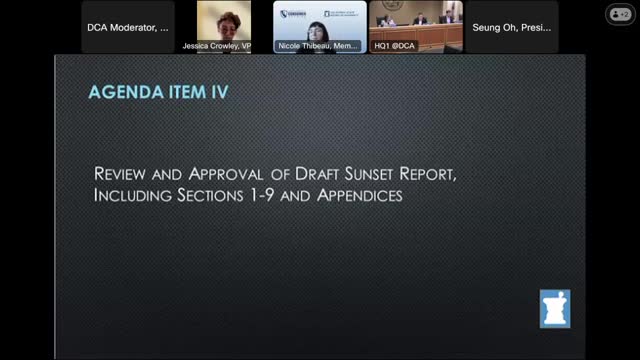California Board Faces Pharmacy Crisis Amid Declining Workforce
December 06, 2024 | California State Board of Pharmacy, Other State Agencies, Executive, California
This article was created by AI summarizing key points discussed. AI makes mistakes, so for full details and context, please refer to the video of the full meeting. Please report any errors so we can fix them. Report an error »

The California State Board of Pharmacy convened on December 4, 2024, to address pressing issues affecting the state's pharmacy landscape, with a significant focus on the declining number of pharmacists and the need for innovative solutions.
During the meeting, board members discussed a draft motion to approve the sunset report, which outlines critical policy work aimed at protecting California consumers. The motion, which received unanimous support, delegates authority to the board president to finalize the report, emphasizing the urgency of addressing the challenges facing the pharmacy sector.
Mark Johnston from CVS Health highlighted the alarming trend of decreasing intern registrations, which could lead to a further decline in pharmacist numbers. He urged the board to consider expanding the duties of pharmacy technicians, citing successful models in other states where technicians perform final verifications without pharmacist oversight. Johnston stressed that embracing technology and innovative practices, such as telepharmacy, could alleviate the pressures on pharmacists and address the growing issue of pharmacy closures.
Public comments echoed these concerns, with several participants advocating for a reevaluation of the California Pharmacy Jurisprudence Exam. Danielle Robinson and John Gray, both pharmacists, called for the board to consider adopting the Multistate Pharmacy Jurisprudence Examination (MPJE) to enhance mobility and opportunities for pharmacists in California. They argued that the current exam may hinder the state's ability to adapt to modern pharmacy practices.
The meeting also touched on the concept of \"pharmacy deserts,\" with suggestions to identify these areas to stimulate job creation and entrepreneurial opportunities for pharmacists. Courtney Schumaker, a pharmacy technician supervisor, echoed the need to expand the role of pharmacy technicians, which could help alleviate the burden on pharmacists and improve service delivery.
As the board prepares to navigate these challenges, the discussions from this meeting signal a proactive approach to reforming pharmacy practice in California, with an emphasis on collaboration, innovation, and consumer protection. The outcomes of these deliberations will be closely watched as they could shape the future of pharmacy practice in the state.
During the meeting, board members discussed a draft motion to approve the sunset report, which outlines critical policy work aimed at protecting California consumers. The motion, which received unanimous support, delegates authority to the board president to finalize the report, emphasizing the urgency of addressing the challenges facing the pharmacy sector.
Mark Johnston from CVS Health highlighted the alarming trend of decreasing intern registrations, which could lead to a further decline in pharmacist numbers. He urged the board to consider expanding the duties of pharmacy technicians, citing successful models in other states where technicians perform final verifications without pharmacist oversight. Johnston stressed that embracing technology and innovative practices, such as telepharmacy, could alleviate the pressures on pharmacists and address the growing issue of pharmacy closures.
Public comments echoed these concerns, with several participants advocating for a reevaluation of the California Pharmacy Jurisprudence Exam. Danielle Robinson and John Gray, both pharmacists, called for the board to consider adopting the Multistate Pharmacy Jurisprudence Examination (MPJE) to enhance mobility and opportunities for pharmacists in California. They argued that the current exam may hinder the state's ability to adapt to modern pharmacy practices.
The meeting also touched on the concept of \"pharmacy deserts,\" with suggestions to identify these areas to stimulate job creation and entrepreneurial opportunities for pharmacists. Courtney Schumaker, a pharmacy technician supervisor, echoed the need to expand the role of pharmacy technicians, which could help alleviate the burden on pharmacists and improve service delivery.
As the board prepares to navigate these challenges, the discussions from this meeting signal a proactive approach to reforming pharmacy practice in California, with an emphasis on collaboration, innovation, and consumer protection. The outcomes of these deliberations will be closely watched as they could shape the future of pharmacy practice in the state.
View full meeting
This article is based on a recent meeting—watch the full video and explore the complete transcript for deeper insights into the discussion.
View full meeting
